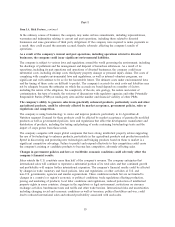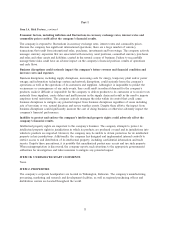DuPont 2006 Annual Report Download - page 20
Download and view the complete annual report
Please find page 20 of the 2006 DuPont annual report below. You can navigate through the pages in the report by either clicking on the pages listed below, or by using the keyword search tool below to find specific information within the annual report.
Item 7. Management’s Discussion and Analysis of Financial Condition and Results of Operations, continued
Going Where the Growth Is — The company has achieved significant growth in emerging markets by
increasing its direct presence and sales efforts including extending the company’s science, products, brands and
market position into new applications and uses. The company has a strong presence in the fastest-growing
emerging markets and continues to leverage resources and market position to realize new growth. Sales
outside of North America, the United Kingdom, Germany, France, Italy and Japan have increased to 36 percent
of total company sales in 2006 from 33 percent in 2004.
Analysis of Operations
During 2006, the company maintained a leading position in biotechnology, safety and protection and crop
yield improvement and continued to execute its growth strategies, while overcoming record-high energy costs.
Management estimates that year over year cost increases for raw materials in 2006 exceeded $800 million,
principally reflecting higher market prices for oil, natural gas and hydrocarbon feedstock and overall tight
supply in certain raw materials. The company took actions to increase pricing and improve productivity to
offset these cost increases, particularly in the Agriculture & Nutrition and Coatings & Color Technologies
platforms where the company initiated restructuring actions to streamline operations and further reduce fixed
costs. The company’s operations have completely recovered from hurricane disruptions of 2005. The most
significant damage was to the company’s DeLisle, Mississippi, titanium dioxide plant which remained shut
down from August 2005 until production began a phased-in restart in January 2006. Normal operations
resumed by the end of the second quarter 2006. In 2006, the company received $204 million in insurance
recoveries related to losses suffered from Hurricane Katrina and asbestos settlements; $128 million is recorded
in Cost of goods sold and other operating charges and $76 million is recorded in Other income, net.
The company adopted a dual approach to quantifying materiality and elected to refine the accounting related
to the following existing cutoff practices. For certain of the company’s sales transactions, ownership title
transfers when goods are received by the customers. Historically, the company recorded these sales when
shipped and monitored the impact of this difference. Additionally, some accruals were historically recorded on
a month-lag basis. The impacts of these sales and accrual cutoff practices were considered to be immaterial in
every interim and annual period. During the fourth quarter of 2006, the company chose to change its practices
to record these sales when received by customers and to record certain accruals without a lag. As a result,
sales of $107 million were not recorded as of December 31, 2006 that historically would have been. If the
company had applied this new practice throughout 2006, sales would have been $81 million higher than
reported. Incremental accruals of $24 million were also recorded at December 31, 2006, that would not have
been recorded under prior practices. The after-tax impact on the 2006 income statement of these changes was
$39 million.
(Dollars in millions) 2006 2005 2004
NET SALES $27,421 $26,639 $27,340
2006 versus 2005 Consolidated net sales for 2006 were $27.4 billion, up 3 percent. The increase reflects
2 percent higher local selling prices and 2 percent higher net volume partially offset by a 1 percent reduction
in worldwide sales attributable to the transfer of certain elastomers assets in 2005. Local selling prices
increased across all regions. During 2006, significant volume increases in key growth regions, particularly
Asia Pacific and Latin America, along with modest growth in Europe, more than offset lower U.S. volume.
Volume declines in the U.S. are largely attributable to lower demand in motor vehicle and residential housing
related markets. These declines more than offset the recovery in the U.S. of titanium dioxide, industrial
chemical and packaging polymer sales lost in 2005 due to hurricane business interruption.
20
Part II
























